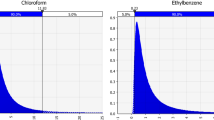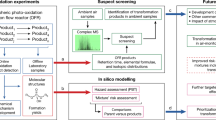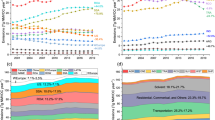Abstract
Although studies of occupational exposure to volatile organic compounds (VOCs) often partition variability across groups, and between and within persons, those of environmental exposure to VOCs have not involved such partitioning. Using data from the Environmental Protection Agency's total exposure assessment methodology (TEAM) studies, we partitioned exposure variability across cities, and between and within persons for nine VOCs. The estimated variance components decreased in the order: within-person > between-person > across city. Despite their smaller magnitudes, estimates of between-person and across-city variance components were sufficiently large to provide reasonable contrast for informative epidemiology studies of most VOCs. Estimates of between-person variance components for environmental VOCs were similar to those published for occupational VOCs (groups defined by job and factory). However, estimates of within-person variance components were much greater for environmental VOCs, probably due to the greater diversity of locations (including the workplace) visited by the general public over time. For benzene and perchloroethylene, we used a simple model to calculate numbers of personal measurements required to relate the exposure level to health outcome statistically. About 10 times more personal measurements would be required to investigate perchloroethylene exposure as compared to benzene exposure; this disparity reflects the greater within-subject variability of perchloroethylene data compared to benzene data. We conclude that variability should be partitioned for environmental VOC exposures in much the same manner as for occupational exposures. There should be sufficient variability in the levels of most VOCs across cities and between subjects to provide reasonable contrast for informative epidemiology studies, as we illustrate for exposures to benzene. Yet, epidemiologists should be wary of investigating environmental VOCs without preliminary data with which to estimate the variance structure of exposure variables.
This is a preview of subscription content, access via your institution
Access options
Subscribe to this journal
Receive 6 print issues and online access
$259.00 per year
only $43.17 per issue
Buy this article
- Purchase on Springer Link
- Instant access to full article PDF
Prices may be subject to local taxes which are calculated during checkout


Similar content being viewed by others
Notes
The following VOCs were investigated: benzene, chloroform, ethylbenzene, methylchloroform, p-dichlorobenzene, perchloroethylene, styrene, trichloroethylene, and o-xylene.
The following VOCs were reported by Kromhout et al.: benzene, diphenyl, diphenylether, ethanal, formaldehyde, an unspecified organic vapor, perchloroethylene, styrene, toluene, total solvents, trichloroethane, and xylene.
The VOCs routinely measured above detection limits were 1,3-butadiene, benzene, toluene, ethylbenzene, p-, m-, and o-xylene, 1,3,5-trimethylbenzene, styrene, p-isopropyltoluene, 1,2,4-trimethylbenzene, p-dichlorobenzene, and naphthalene. Sampled locations included homes, offices, restaurants, pubs, department stores, cinemas, perfume shops, libraries, laboratories, train stations, trafficked roads, cars, trains, and buses.
References
Armstrong B.G . Effect of measurement error on epidemiological studies of environmental and occupational exposures. Occup Environ Med 1998: 55(10): 651–656.
Brunekreef B., Noy D., and Clausing P . Variability of exposure measurements in environmental epidemiology. Am J Epidemiol 1987: 125(5): 892–898.
Burstyn I., Boffetta P., Burr G.A., Cenni A., Knecht U., Sciarra G., et al. Validity of empirical models of exposure in asphalt paving. Occup Environ Med 2002: 59(9): 620–624.
Burstyn I., Boffetta P., Kauppinen T., Heikkila P., Svane O., Partanen T., et al. Performance of different exposure assessment approaches in a study of bitumen fume exposure and lung cancer mortality. Am J Ind Med 2003a: 43(1): 40–48.
Burstyn I., Boffetta P., Kauppinen T., Heikkila P., Svane O., Partanen T., et al. Estimating exposures in the asphalt industry for an international epidemiological cohort study of cancer risk. Am J Ind Med 2003b: 43(1): 3–17.
Egeghy P.P., Nylander-French L., Gwin K.K., Hertz-Picciotto I., Rappaport S.M . Self-collected breath sampling for monitoring low-level benzene exposures among automobile mechanics. Ann Occup Hyg 2002: 46(5): 489–500.
Egeghy P.P., Tornero-Velez R., and Rappaport SM . Environmental and biological monitoring of benzene during self-service automobile refueling. Environ Health Perspect 2000: 108(12): 1195–1202.
Hoffmann K., Krause C., Seifert B., and Ullrich D . The German Environmental Survey 1990/92 (GerES II): sources of personal exposure to volatile organic compounds. J Expos Anal Environ Epidemiol 2000: 10(2): 115–125.
Janssen N.A., Hoek G., Harssema H., and Brunekreef B . Childhood exposure to PM10: relation between personal, classroom, and outdoor concentrations. Occup Environ Med 1997: 54(12): 888–894.
Janssen N.A., Hoek G., Harssema H., and Brunekreef B . Personal sampling of airborne particles: method performance and data quality. J Expos Anal Environ Epidemiol 1998: 8(1): 37–49.
Janssen N.A., Hoek G., Harssema H., and Brunekreef B . Personal exposure to fine particles in children correlates closely with ambient fine particles. Arch Environ Health 1999: 54(2): 95–101.
Kim Y.M., Harrad S., and Harrison R.M . Concentrations and sources of VOCs in urban domestic and public microenvironments. Environ Sci Technol 2001: 35(6): 997–1004.
Kinney P.L., Chillrud S.N., Ramstrom S., Ross J., and Spengler J.D . Exposures to multiple air toxics in New York City. Environ Health Perspect 2002: 110 (Suppl. 4): 539–546.
Kromhout H., and Heederik D . Occupational epidemiology in the rubber industry: implications of exposure variability. Am J Ind Med 1995: 27(2): 171–185.
Kromhout H., Swuste P., and Boleij J.S . Empirical modelling of chemical exposure in the rubber-manufacturing industry. Ann Occup Hyg 1994: 38(1): 3–22.
Kromhout H., Symanski E., and Rappaport S.M . A comprehensive evaluation of within- and between-worker components of occupational exposure to chemical agents. Ann Occup Hyg 1993: 37(3): 253–270.
Kromhout H., and van Tongeren M . How important is personal exposure assessment in the epidemiology of air pollutants? Occup Environ Med 2003: 60(2): 143–144.
Liljelind I.E., Rappaport S.M., Levin J.O., Stromback A.E., Sunesson A.L., and Jarvholm B.G . Comparison of self-assessment and expert assessment of occupational exposure to chemicals. Scand J Work Environ Health 2001: 27(5): 311–317.
Liljelind I.E., Stromback A.E., Jarvholm B., Levin J.O., Strangert B.L., and Sunesson A.-L.K . Self-assessment of exposure: a pilot study of assessment of exposure to benzene in tank truck drivers. Appl Occup Environ Hyg 2000: 15: 195–202.
Navidi W., and Lurmann F . Measurement error in air pollution exposure assessment. J Expos Anal Environ Epidemiol 1995: 5(2): 111–124.
Navidi W., Thomas D., Stram D., and Peters J . Design and analysis of multilevel analytic studies with applications to a study of air pollution. Environ Health Perspect 1994: 102 (Suppl. 8): 25–32.
Peretz C., Goldberg P., Kahan E., Grady S., and Goren A . The variability of exposure over time: a prospective longitudinal study. Ann Occup Hyg 1997: 41(4): 485–500.
Peretz C., Goren A., Smid T., and Kromhout H . Application of mixed-effects models for exposure assessment. Ann Occup Hyg 2002: 46(1): 69–77.
Rappaport SM . Assessment of long-term exposures to toxic substances in air. Ann Occup Hyg 1991: 35(1): 61–121.
Rappaport S.M., Waidyanatha S., Qu Q., Shore R., Jin X., Cohen B., et al. Albumin adducts of benzene oxide and 1,4-benzoquinone as measures of human benzene metabolism. Cancer Res 2002: 62(5): 1330–1337.
Rappaport S.M., Weaver M., Taylor D., Kupper L., and Susi P . Application of mixed models to assess exposures monitored by construction workers during hot processes. Ann Occup Hyg 1999: 43(7): 457–469.
Rijnders E., Janssen N.A., van Vliet P.H., and Brunekreef B . Personal and outdoor nitrogen dioxide concentrations in relation to degree of urbanization and traffic density. Environ Health Perspect 2001: 109 (Suppl. 3): 411–417.
Sherwood R.J., and Greenhalgh D.M.S . A personal air sampler. Ann Occup Hyg 1960: 2: 127–132.
Spengler J., Schwab M., Ryan P.B., Colome S., Wilson A.L., Billick I., et al. Personal exposure to nitrogen dioxide in the Los Angeles Basin. J Air Waste Manage Assoc 1994: 44(1): 39–47.
Spiegelman D., McDermott A., and Rosner B . Regression calibration method for correcting measurement-error bias in nutritional epidemiology. Am J Clin Nutr 1997: 65 (Suppl. 4): 1179S–1186S.
Symanski E., Chan W., and Chang C.C . Mixed-effects models for the evaluation of long-term trends in exposure levels with an example from the nickel industry. Ann Occup Hyg 2001: 45(1): 71–81.
Symanski E., Kupper L.L., Kromhout H., and Rappaport S.M . An investigation of systematic changes in occupational exposure. Am Ind Hyg Assoc J 1996: 57(8): 724–735.
Tielemans E., Heederik D., Burdorf A., Vermeulen R., Veulemans H., Kromhout H., et al. Assessment of occupational exposures in a general population: comparison of different methods. Occup Environ Med 1999: 56(3): 145–151.
Tielemans E., Kupper L.L., Kromhout H., Heederik D., and Houba R . Individual-based and group-based occupational exposure assessment: some equations to evaluate different strategies. Ann Occup Hyg 1998: 42(2): 115–119.
van Tongeren M., Gardiner K., Calvert I., Kromhout H., and Harrington J.M . Efficiency of different grouping schemes for dust exposure in the European carbon black respiratory morbidity study. Occup Environ Med 1997: 54(10): 714–719.
Wallace L., Nelson W., Ziegenfus R., Pellizzari E., Michael L., Whitmore R., et al. The Los Angeles TEAM Study: personal exposures, indoor-outdoor air concentrations, and breath concentrations of 25 volatile organic compounds. J Expos Anal Environ Epidemiol 1991: 1(2): 157–192.
Wallace L.A . The Total Exposure Assessment Methodology (TEAM) Study: Summary and Analysis: Volume I. Office of Research and Development, US Environmental Protection Agency, Washington, DC, 1987.
Wallace L.A . Personal exposure to 25 volatile organic compounds. EPA's 1987 team study in Los Angeles, California. Toxicol Ind Health 1991: 7(5–6): 203–208.
Wallace L.A . Human exposure to volatile organic pollutants: implications for indoor air studies. Annu Rev Energy Environ 2001: 26: 269–301.
Wallace L.A., Pellizzari E.D., Hartwell T.D., Whitmore R.W., Zelon H., Perritt R., et al. The California TEAM study: breath concentrations and personal exposures to 26 volatile compounds in air and drinking water of 188 residents of Los Angeles, Antioch, and Pittsburgh, CA. Atmos Environ 1988: 22(10): 2141–2163.
Zeger S.L., Thomas D., Dominici F., Samet J.M., Schwartz J., Dockery D., et al. Exposure measurement error in time-series studies of air pollution: concepts and consequences. Environ Health Perspect 2000: 108(5): 419–426.
Acknowledgements
This work was supported by the National Institute for Environmental Health Sciences through Grants P42ES05948 and P30ES10126. The authors appreciate the assistance of Dr. Peter Egeghy in downloading data from EPA's online database.
Author information
Authors and Affiliations
Corresponding author
Appendices
Appendix A
Samples of data obtained from the TEAM database, providing personal and outdoor air concentrations, day and night, for nine VOCs are summarized in Table A1
Appendix B
Derivation of a relationship to predict sample sizes
Assume exposure Model (1) with kh=k subjects in the hth city (h=1, 2, …, H>3) and nhi=n measurements/subject), and assume that each person is assigned his/her city's observed mean (log-scale) exposure

(since μyhi is unobservable in Model (4)), where

is the observed (log-scale) mean exposure for the ith person in the hth city. Then the unweighted least-squares estimator of β1 in Model (4), using a group-based analysis, is

where

and

Using relationships given by Tielemans et al. (1998), we can show that the expected value of θ̂*1 is E(θ̂*1)=cβ1, where

and where σα2, σB2, and σW2 are defined under Model (1). Also the standard error of θ̂*1 has the form:

Using the above relationships for E(θ̂1*) and SE(θ̂1*) and assuming the variance components σ2e, σ2α, σ2B, and σ2W are known (a standard assumption for such sample size derivations), a 100(1−α)% large-sample approximate confidence interval for θ1 is

Assuming θ1>0 (indicating an adverse effect of exposure on the health outcome), we seek choices for H(>3), k, and n (≥2) satisfying the following inequality:

where (1−β) is the smallest probability we would accept for the event that the lower limit of the confidence interval exceeds zero. For large samples, we equivalently have

where Z is approximately a standard normal deviate. Hence, we require

leading to

After substituting for c and SE(β̂*1), we obtain

After some manipulation, this leads to Eq. (5) in the text.
Appendix C
Statistics for VOC concentrations (μg/m3) from 24-h personal measurements in five US cities (1981–1987) are summarized in Table C1.
Appendix D
Statistics for VOC concentrations (μg/m3) from 24-h outdoor measurements in five US cities (1981–1987) are summarized in Table D1.
Appendix E
Spearman's correlation coefficients for 24-h personal measurements of nine VOCs in five US cities are summarized in Table E1. See Appendix A for nominal sample sizes
Rights and permissions
About this article
Cite this article
Rappaport, S., Kupper, L. Variability of environmental exposures to volatile organic compounds. J Expo Sci Environ Epidemiol 14, 92–107 (2004). https://doi.org/10.1038/sj.jea.7500309
Received:
Accepted:
Published:
Issue Date:
DOI: https://doi.org/10.1038/sj.jea.7500309
Keywords
This article is cited by
-
Green Catalytic Degradation of Ethyl Acetate Incurred by Strong Interaction Between PdO and Ce0.5Co0.5 Support at Low Temperature
Catalysis Letters (2017)
-
Determinants of personal exposure to some carcinogenic substances and nitrogen dioxide among the general population in five Swedish cities
Journal of Exposure Science & Environmental Epidemiology (2014)
-
New approach for particulate exposure monitoring: determination of inhaled particulate mass by 24 h real-time personal exposure monitoring
Journal of Exposure Science & Environmental Epidemiology (2012)
-
Variability of environmental exposure to fine particles, black smoke, and trace elements among a Swedish population
Journal of Exposure Science & Environmental Epidemiology (2011)
-
Relative performance of different exposure modeling approaches for sulfur dioxide concentrations in the air in rural western Canada
BMC Medical Research Methodology (2008)



